#Schomburg Center for Research in Black Culture
Photo
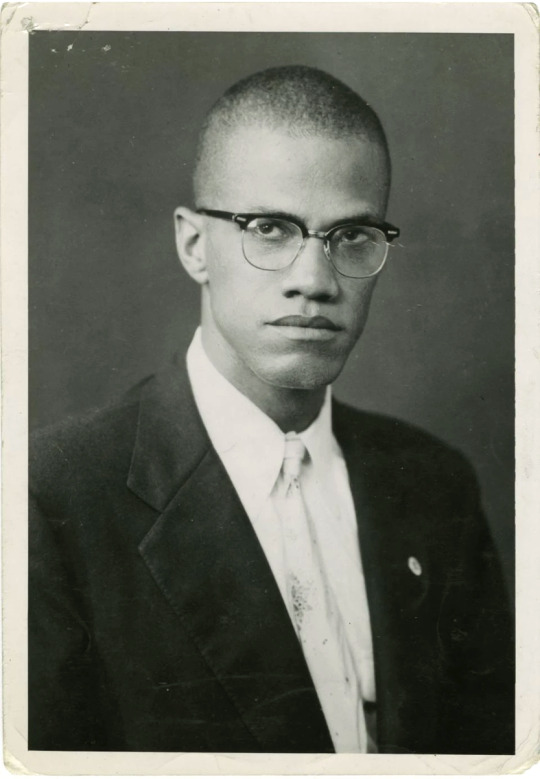
Malcolm X (May 19, 1925 – February 21, 1965)
(image: Portrait of Malcolm X, 1950s, Photographer unknown. Photographs and Prints Division, Schomburg Center for Research in Black Culture, New York Public Library, New York, NY)
#photography#malcolm x#schomburg center for research in black culture#new york public library#1920s#1950s#1960s
677 notes
·
View notes
Text

Catherine Latimer: The New York Public Library's First Black Librarian
On a beautiful September morning in 1921, the young poet, Langston Hughes, exited the subway at 135th Street and Lenox Avenue in Harlem. In 1921 Harlem was fast becoming a burgeoning mecca for black artists, writers, and performers. After making a few stops, Langston found his way to the Harlem Branch Library where, as he described, a “warm and wonderful librarian, Miss Ernestine Rose, white, made newcomers feel welcome, as did her assistant in charge of the Schomburg Collection*, Catherine Latimer, a luscious cafe au lait.” Although, only in the position one year when Langston Hughes made his observations, Catherine Latimer would go on to play a significant role in the history of the Schomburg Center for Research in Black Culture and The New York Public Library as, among other things, NYPL’s first African American librarian.
#Black History Month#libraries#librarians#Catherine Latimer#Schomburg Center for Research in Black Culture#NYPL
69 notes
·
View notes
Text

Eartha Kitt (right) teaching a dance class at the Harlem YMCA. 1955. Schomburg Center for Research in Black Culture, Photographs and Prints Division, The New York Public Library.
#Eartha Kitt#Black dancers#Harlem#Black Radical Women#Black archives#Black women#Schomburg Center for Research in Black Culture#Black photography
6 notes
·
View notes
Note
any recommendations/personal favourites from the image collections to print out and make a wall collage out of? (extra love if it’s not artstor, my uni doesnt have a subscription to that)
I love this question! It very much depends on your personal vibe, but here's a list of every collection designated as open to get you started:
Folger Shakespeare Library
Images from the History of Medicine
Museum of New Zealand - Te Papa Tongarewa
Schomburg Center for Research in Black Culture
Science Museum Group
Smithsonian National Museum of African American History and Culture
Statens Museum for Kunst-National Gallery of Denmark
The Cleveland Museum of Art
The Metropolitan Museum of Art
Wellcome Collection
#i am partial to the metropolitan museum of art but that's just me#jstor#ask#open access#open content#image collections
221 notes
·
View notes
Text

Lily Yuen Collection, 1926-1930. Schomburg Center for Research in Black Culture
71 notes
·
View notes
Text
Bayard Rustin
Back when I was working as an archivist at the American Jewish Historical Society at the Center for Jewish History in Manhattan, one of the most interesting figures I had the pleasure of learning about was proudly and publicly gay Civil Rights activist, advisor to Dr. Martin Luther King, and firm believer in the importance of Black and Jewish American communal solidarity: Bayard Rustin.

Bayard Rustin standing on a stage and speaking to a crowd from a podium at the 1967 NAACP Conference in Albany, New York. Image courtesy of the NMAAHC.
Check out the small, but fascinating collection here! The Schomburg Center for Research in Black Culture highly recommends this study of Mr. Rustin, and the NMAAHC has a fantastic bio here, with a link to further collections materials. I also highly recommend taking a look at some of the photos and related collections held by the Library of Congress.
As some of you may know, a well-received biopic of this fascinating figure was recently released. And incidentally, my dear friend and DC-based actor, Emily Gilson, had a small, but impactful role in the film as "Little Rock White Girl."
Check it out! Or at least, check out some of these fantastic collections.
99 notes
·
View notes
Text

Today We Honor Arturo Alfonso Schomburg
One of the most influential forces behind the creation of The New York Public Library’s Schomburg Center for Research in Black Culture is the man the research center is named after, Arturo Alfonso Schomburg.
Born in Puerto Rico in 1874, Schomburg was a Puerto Rican of African and German descent. Young Arturo often wondered about the lack of African history taught in his classrooms. This interest formed the cornerstone of Schomburg’s eventual lifework consisting of research and preservation—work that would lead him to become one of the world’s premier collectors of Black literature, slave narratives, artwork, and diasporic materials.
During the 1920s and '30s, Schomburg traveled to Europe, Latin America, and across the United States collecting new materials that bolstered his already voluminous collection, and in 1926 the Carnegie Corporation funded The New York Public Library’s purchase of Schomburg’s private collection for $10,000.
This would mark the beginning of the 135th Street branch’s transformation into the Schomburg Center.
Schomburg’s curation work was so heralded that in 1929, Fisk University President Charles S. Johnson invited him to curate Fisk’s library. By assisting in the architectural design of the library and focusing on providing equitable experiences for researchers, including the building of a reading room and browsing space, Schomburg helped cement Fisk’s standing as one of the leading institutions on Black research and studies. By the time Schomburg ended his tenure at Fisk, the library’s collection had expanded to 4,600 books from a mere 106 items.
CARTER™️ Magazine carter-mag.com #wherehistoryandhiphopmeet #historyandhiphop365 #cartermagazine #carter #arturoschomburg #blackhistorymonth #blackhistory #history #staywoke
#carter magazine#carter#historyandhiphop365#wherehistoryandhiphopmeet#history#cartermagazine#today in history#staywoke#blackhistory#blackhistorymonth#Arturo Schomburg
124 notes
·
View notes
Text
Arturo Alfonso Schomburg is someone I wish more people would talk about. He moved to the United States in 1891, where he ended up making contributions that Afro-Latinan Americans and African Americans have made to society. He was an important intellectual figure in the Harlem Renaissance. Over the years, he collected literature, art, slave narratives, and other materials of African history, which were purchased to become the basis of the Schomburg Center for Research in Black Culture, named in his honour, at the New York Public Library (NYPL) branch in Harlem.
41 notes
·
View notes
Text
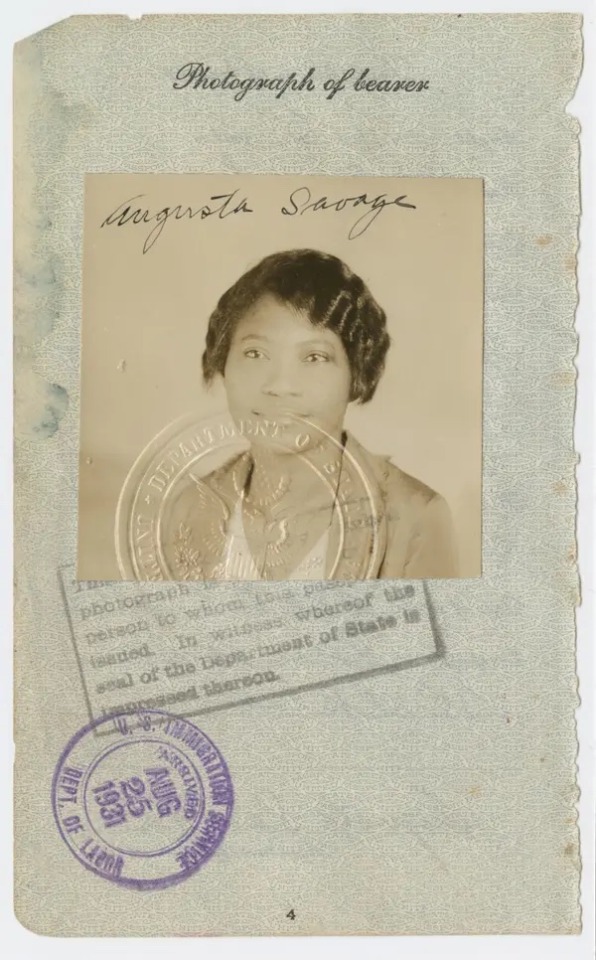
The 1931 passport photograph of the sculptor Augusta Savage.
Credit: Schomburg Center for Research in Black Culture, Photographs and Prints Division, the New York Public Library
38 notes
·
View notes
Text
THIS DAY IN GAY HISTORY
based on: The White Crane Institute's 'Gay Wisdom', Gay Birthdays, Gay For Today, Famous GLBT, glbt-Gay Encylopedia, Today in Gay History, Wikipedia, and more … February 1


February Is LGBT History Month In The United Kingdom

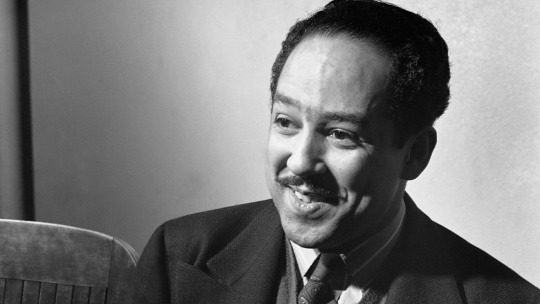
1902 – The American poet, novelist, playwright, short story writer, and columnist Langston Hughes was born in Joplin, Missouri (d.1967). Hughes is known for his work during the Harlem Renaissance.
Academics and biographers today acknowledge that Hughes was a homosexual and included homosexual codes in many of his poems, similar in manner to Walt Whitman, whose work Hughes cited as another influence on his poetry, and most patently in the short story Blessed Assurance which deals with a father's anger over his son's effeminacy and queerness.
It has been noted that to retain the respect and support of black churches and organizations and avoid exacerbating his precarious financial situation, Hughes remained closeted. Arnold Rampersad, the primary biographer of Hughes —though he documents Hughes's admission of a homosexual encounter with a seaman in 1926—asserts that he could not find incontrovertible evidence that the writer was gay. He did determine that Hughes exhibited a preference for other African American men in his work and life This love of black men is evidenced in a number of reported unpublished poems to a black male lover.
Recently, scholars have started to pay attention to the influence of homosexuality on Hughes's literary imagination. Many of Hughes's poems invite gay readings. Such poems enable scholars to theorize on the poet's use of the male-male gaze as a common feature in his writings.
Focusing on such poems as "Joy," "Desire," "Café: 3 A. M.," "Waterfront Streets," "Young Sailor," "Trumpet Player," "Tell Me," and many poems in Montage of a Dream Deferred (1951), we can identify homoeroticism and other gay markings.
On May 22, 1967, Hughes died at the age of 65 from complications after abdominal surgery. His ashes are interred beneath a floor medallion in the middle of the foyer leading to the auditorium named for him within the Arthur Schomburg Center for Research in Black Culture in Harlem. The design on the floor covering his cremated remains is an African cosmogram titled "Rivers." The title is taken from the poem "The Negro Speaks of Rivers" by Hughes. Within the center of the cosmogram and precisely above the ashes of Hughes are the words "My soul has grown deep like the rivers."

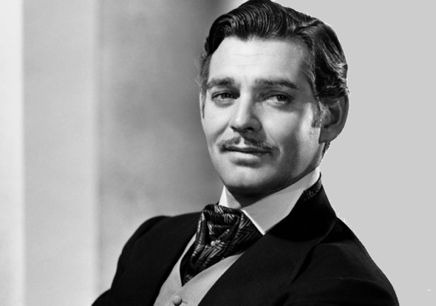
1901 – Clark Gable (d.1960) was an American film actor, often referred to as The King of Hollywood or just simply as The King. Gable began his career as a stage actor and appeared as an extra in silent films between 1924 and 1926, and progressed to supporting roles with a few films for MGM in 1931. The next year he landed his first leading Hollywood role and became a leading man in more than 60 motion pictures over the next three decades.
Gable was arguably best known for his role as Rhett Butler in the epic Gone with the Wind (1939), for which he received his third nomination for the Academy Award for Best Actor. He was also nominated for leading roles in Mutiny on the Bounty (1935), and he won for It Happened One Night (1934).His final screen appearance was The Misfits (1961) with Marilyn Monroe and Montgomery Clift.
When Clark Gable first arrived in Hollywood in 1925, he would do anything or use anyone to advance his career. His first two wives were decidedly unglamorous older women; he was a kept man living the lifestyle of a star. As soon as Gable touched the limelight, he abandoned his second wife and followed wherever his penis led. He tore through Hollywood’s women with the appetite of a starving teenager, with one notable exception.
Gable had one homosexual encounter that is well documented. The young Clarke Gable engaged in oral sex with fellow MGM player Billy Haines in order to establish himself at the studio. Billy Haines, who was the most popular male film star of 1930, was the hub of gay Hollywood. He told all his friends about his sexual hookup with Clark Gable in the late 1920s, which was unusual, since Haines usually never bragged about such things. Haines knew first hand the damage that could be caused by a public knowledge of homosexuality. Joan Crawford confirmed the story, and her testament holds up under scrutiny because she was the lifelong best friend of both men. She had no reason to lie about either star, and she cherished the friendship of both.
More than ten years later Gable avenged his gay encounter. Hollywood was awash with both homosexuals and Jews, and Gable let it be known that he held both in disdain. By 1939 Gable had come to personify the image of a super macho male star. During filming of Gone with the Wind, Gable was uncomfortable by the presence of Billy Haines, who visited the set as a guest of director George Cukor (who was both homosexual and Jewish).The legend goes that actor Andy Lawler was at a Hollywood party later and announced, quite loudly and quite likely high on cocaine, that "George is directing one of Billy's old tricks." The laugh at Gable’s expense got back to him, and he was outraged. He snarled on set, "I won't be directed by a fairy," which so enraged Cukor that he walked off the set.
MGM decided it needed Gable more than Cukor for this project, and Victor Fleming was ushered in as replacement director, even though Cukor had already worked for two years on preproduction and early filming. Although Gone with the Wind became one of the great films of all time, the incident didn’t harm the career of George Cukor, who immediately began working on The Women and continued to make top grossing films.
Gable was crowned “The King of Hollywood”, but Carol Lombard joked: "if his cock was one inch shorter, they'd be calling him "the Queen of Hollywood. God knows I love Clark, but he's the worst lay in town."
And Tallulah Bankhead commented, "if his dick was one inch shorter, his name would be Betty Grable, not Clark Gable."

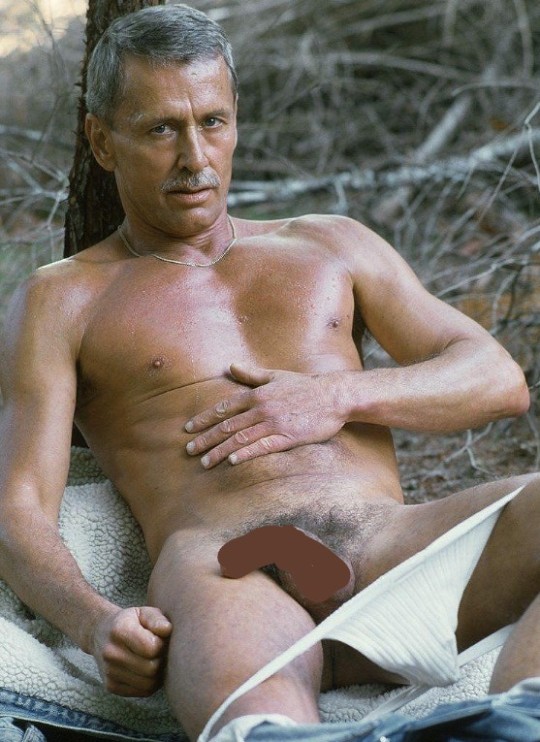
1935 – Christian Haren, prominent AIDS activist, entrepreneur, and actor, was born (d.1996).
Born and raised in California, Haren served a short stint in the army. After leaving the service, he began working as an actor. In the 1960s Haren received a studio contract from MGM and starred in Vincente Minnelli's Bells Are Ringing, Otto Preminger's In Harm's Way, and Billy Rose's Jumbo. He starred on Broadway in the Bertolt Brecht play The Resistible Rise of Arturo Ui, produced by Tony Richardson.
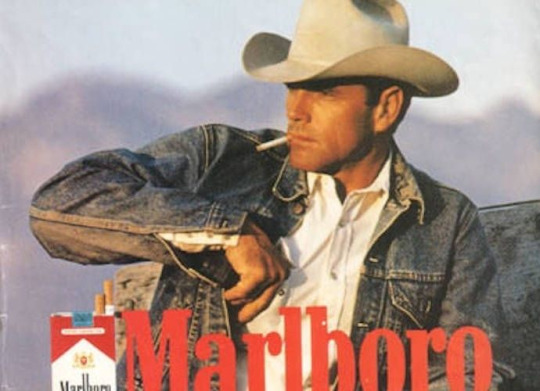
He is best remembered for playing the role of the Marlboro Man in print advertisements in the early 1960s.
Haren was openly gay and the proprietor of the popular Palm Springs gay bar CC Construction Co. in later years. In 1985 he was diagnosed with AIDS and became active in AIDS prevention education. He started "The Wedge", a "safe sex" AIDS prevention organization for teens in San Francisco. Haren died on February 27, 1996, in San Francisco, California of complications from AIDS, aged 61. His life was the subject of the 1998 documentary short Castro Cowboy.

1949 – France: The Paris Prefect of Police issues a decree forbidding men from dancing together in public.


1983 – Ronnie Kroell is an American fashion model, actor & singer best known for appearing on the first season of the Bravo reality series Make Me a Supermodel.
Kroell was born in Chicago, Illinois, and attended Niles North High School in Skokie. There, he became interested in theater. After a break, he attended Harper College, earning his associate degree in political science.
Kroell appeared on season one of Bravo's Make Me a Supermodel. In the show, Ronnie entered into a notable bromance with fellow contestant Ben DiChiara, which was dubbed "Bronnie". He became very popular on the show and won the title of "Fan Favorite" despite placing second behind Holly Kiser.
Following his appearance on the series, Kroell continued to work to establish himself as a model. He signed a contract with New York Model Management and has walked the catwalks for designers such as Philip Sparks, Loris Diran, Malan Breton and Richie Rich. He also featured the cover of Next and Instinct magazines. In June 2010, Ronnie graced the cover of Playgirl magazine along with a provocative layout shot by the internationally renowned fashion photographer Lope Navo. Kroell is currently working on developing a fragrance line and filming a new reality show. Ronnie is the founder of the Friend Movement,LLC organization which is supported by celebrity friends Lisa Vanderpump & Adam Lambert. Kroell co starred in the fourth installment of Q. Allan Brocka's popular Eating Out series, "Eating Out 4: Drama Camp". Ronnie made an appearance in the Andrew Christian mini-challenge as a featured underwear model in an episode of RuPaul's Drag Race.
Kroell is openly gay. Ronnie has been the guest of honor and/or the grand marshal at gay pride events all across the United States.
Ronnie is very much involved in charity and awareness campaigns. Kroell has also contributed to the "I talk about HIV/AIDS Because..." campaign. In addition, Ronnie has worked with Equality Maryland, Gay & Lesbian Alliance Against Defamation (GLAAD), Human Rights Campaign, American Civil Liberties Union (ACLU), the Latino Commission on AIDS (LCOA).

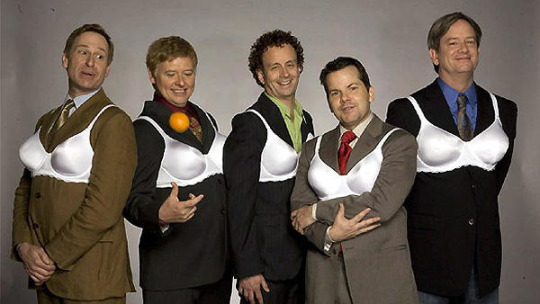
1988 – In February, The Kids in the Hall, a sketch comedy series whose cast includes the openly gay Scott Thompson, debuts on CBC Television. Sketches such as Thompson's character Buddy Cole and the ensemble sketch "The Steps" were among the most visible representations of gay culture on Canadian television during the show's run.
The Kids in the Hall comedy group formed in 1984, consisting of comedians Dave Foley, Kevin McDonald, Bruce McCulloch, Mark McKinney, and Scott Thompson. Their eponymous television show ran from 1988 to 1994 on CBC in Canada, and 1989 to 1995 on CBS and HBO in the United States.
The name of the group came from Sid Caesar, who, if a joke didn't go over, or played worse than expected, would attribute it to "the kids in the hall," referring to a group of young writers hanging around the studio.
The show's sketches were reminiscent of Monty Python's Flying Circus: often quirky or surreal, frequently utilizing drag, with very few celebrity impressions or pop culture parodies; the only recurring celebrity impression was of Queen Elizabeth II, played by Thompson. A recurring character was Mr. Tyzik, played by McKinney, who pretended to crush people's heads from a distance with his fingers. McKinney also played Chicken Lady, a shrill-voiced sexually excitable human-chicken hybrid. Many of the sketches featured gay characters and themes; most of these sketches were written by and starred Scott Thompson, who is openly gay. The show was also notable for reflecting and dealing with the youth subculture of its times, and for incisive sketches about big business and family units.

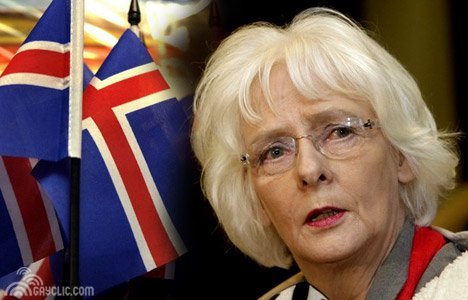
2009 – On this date Jóhanna Sigurðardóttir became the world's first openly Gay prime minister, when Iceland elected her to head up a new parliament. In 2002 she joined in a civil union with the Icelandic author and playwright. The couple legally maried in 2010. Jónína Leósdóttir.

2012 – An utterly misnamed group called OneMillionMoms made headlines by calling for a boycott of the Dallas-based department store JC Penney for having hired Ellen DeGeneres as its spokesperson. A "project" of the hate group American Family Association, OneMillionMoms was offended that JC Penney had hired an open homosexual spokesperson when most of its customers are "traditional families."
In response to the organization's threat of a boycott, JC Penney president Michael Francis issued a press release declaring, "We share the same fundamental values as Ellen. We couldn't think of a better partner to help us put the fun back into the retail experience."


11 notes
·
View notes
Text

Malcolm X, The Ballot or the Bullet (Notes), 1964 [Schomburg Center for Research in Black Culture, Manuscripts, Archives and Rare Books Division, New York Public Library, New York, NY]
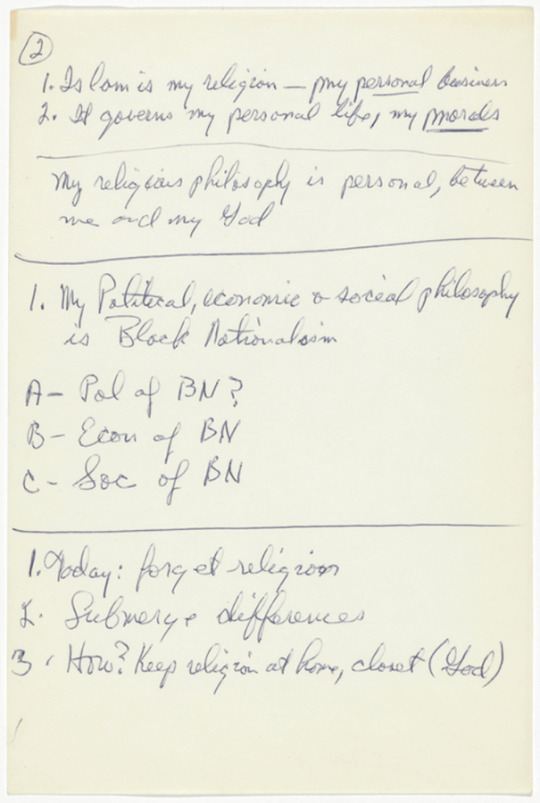

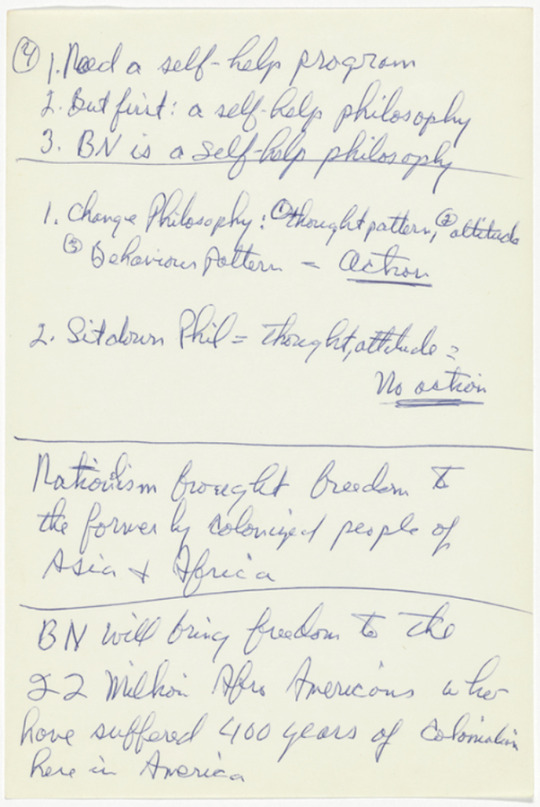


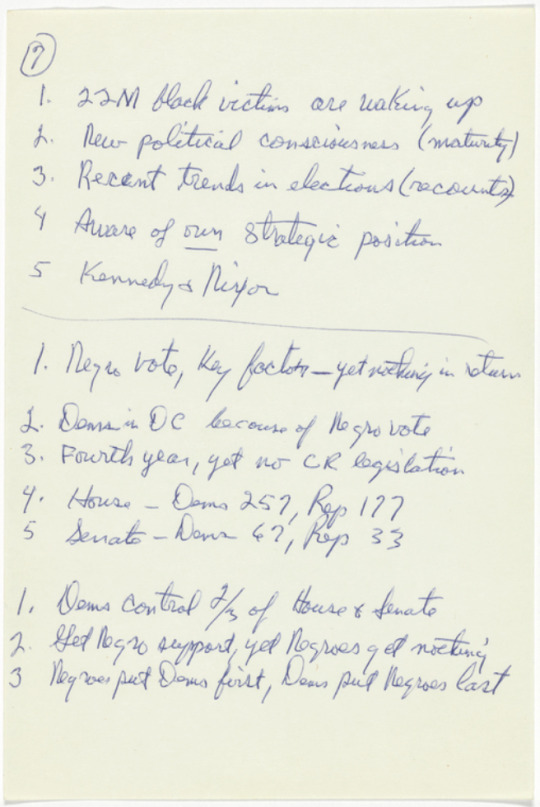
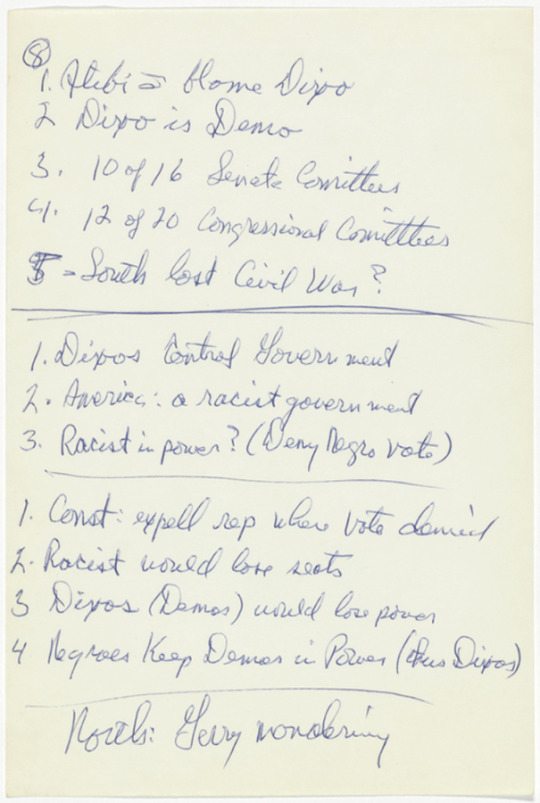
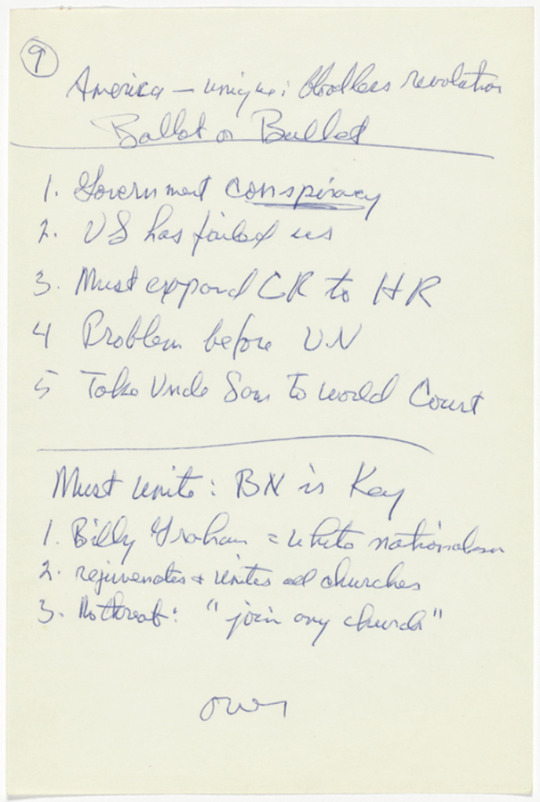
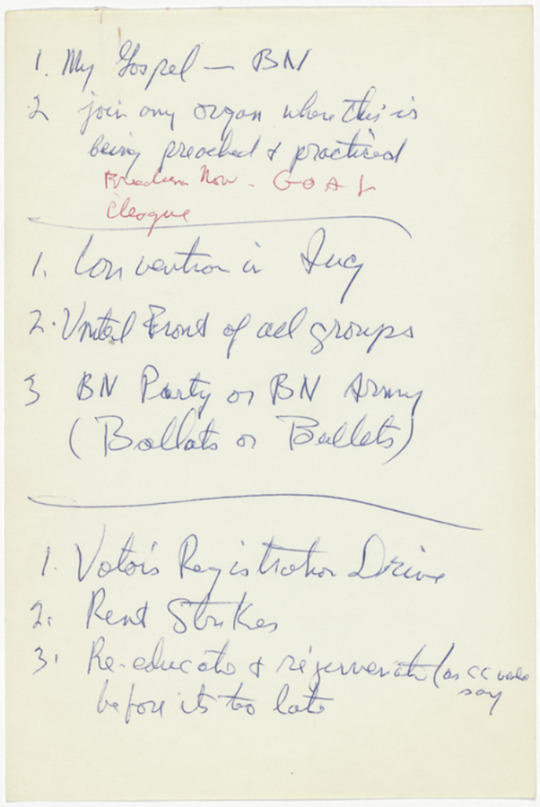
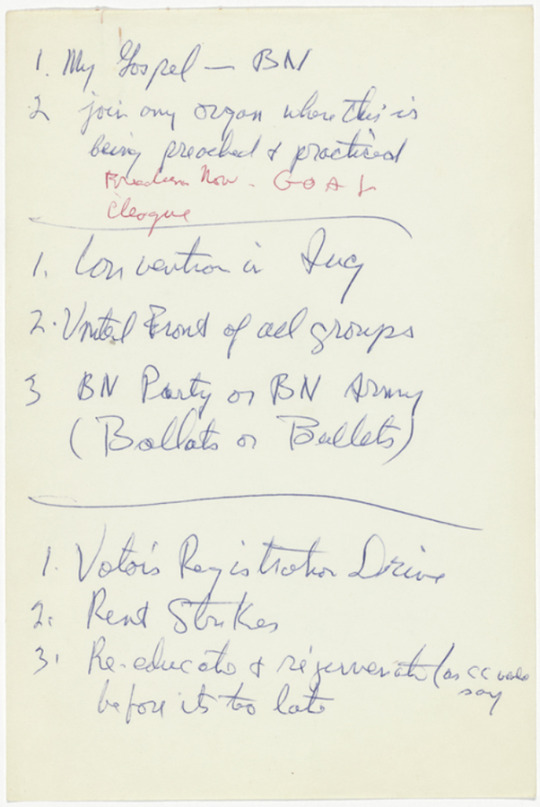
Speech delivered on two occasions: Cory Methodist Church, Cleveland, OH, April 3, 1964; King Solomon Baptist Church, Detroit, MI, April 12, 1964
Audio: Malcolm X, The Ballot or the Bullet, King Solomon Baptist Church, Detroit, MI, April 12, 1964 [Atlanta University Center – Robert W. Woodruff Library, Atlanta, GA]
#manuscript#handwriting#notation#speech#audio#malcolm x#cory methodist church#king solomon baptist church#schomburg center for research in black culture#new york public library#atlanta university center robert w. woodruff library#1960s
23 notes
·
View notes
Photo
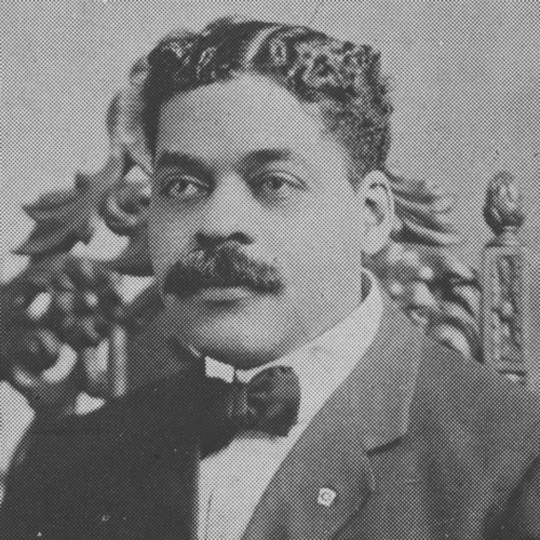



“We need the historian and philosopher to give us with trenchant pen, the story of our forefathers, and let our soul and body, with phosphorescent light, brighten the chasm that separates us. We should cling to them just as blood is thicker than water. American Negro must remake his past in order to make his future.”
...
Arturo Alfonso Schomburg, collector, archivist, writer, activist, and important figure of the Harlem Renaissance was born in San Juan, Puerto Rico on January 24, 1874. His mother was a black woman originally from St. Croix, Danish Virgin Islands (now the U.S. Virgin Islands), and his father was a Puerto Rican of German ancestry.
Seventeen-year-old Schomburg migrated to New York City in 1891. Very active in the liberation movements of Puerto Rico and Cuba, he founded, in 1892, Las dos Antillas, a cultural and political group that worked for the islands’ independence from Spain. After the collapse of the Cuban revolutionary struggle, and the cession of Puerto Rico to the United States, Schomburg, disillusioned, turned his attention to the history and culture of Africa and what we know today as the African Diaspora.
In 1911, as its Master, he renamed El Sol de Cuba #38, a lodge of Cuban and Puerto Rican immigrants, as Prince Hall Lodge in honor of the first African American freemason. The same year, he founded, with journalist John Edward Bruce, the Negro Society for Historical Research which gathered African, Caribbean, and African American scholars. In 1922 he was elected president of the American Negro Academy.
Schomburg firmly believed that “The American Negro must remake his past in order to make his future.” The first part of this process was to reclaim history by evidencing Black people’s contributions to history and culture. Working as a mailroom supervisor at a Brooklyn bank, Schomburg spent his free time and resources, and his retirement after 1930, collecting materials on Africa and its Diaspora. He traveled through the United States, Europe, and Latin America, amassing over 10,000 books, manuscripts, sheet music, photographs, newspapers, periodicals, pamphlets, and artwork.
The second phase of Schomburg’s project was to bring this knowledge to the public. He lent numerous items to schools, libraries, and conferences and organized exhibitions. He wrote articles for a diversity of publications: Marcus Garvey’s Negro World; the NAACP’s The Crisis edited by W. E. B. Du Bois; The Messenger, founded by Socialists A. Philip Randolph and Chandler Owen; the organ of the National Urban League, Opportunity; and Harlem’s newspaper, The Amsterdam News.
In 1926 the Carnegie Corporation bought Schomburg’s collection for $10,000 (about $125,000 today) on behalf of The New York Public Library. The collection was added to the Division of Negro Literature, History and Prints of the Harlem branch on 135th Street.
From 1929 to 1932 Schomburg worked as a curator at Fisk University’s library and was instrumental in expanding its collection from 100 to 4,600 items. Back in New York, he was appointed curator of The New York Public Library’s Harlem Division. He held the position until his death on June 10, 1938 in Brooklyn. He was 64. In his honor, the Division was renamed the Schomburg Collection of Negro Literature, History and Prints in 1940. Arturo Schomburg’s enduring legacy was further acknowledged when the Collection became the Schomburg Center for Research in Black Culture of The New York Public Library in 1972. With over 11 million items, it is one of the world’s foremost research centers on Africa and the African Diaspora.
Legendary.
71 notes
·
View notes
Text

Writer and music critic Amiri Baraka, who was born on this date in 1934, with poet, screenwriter and activist Maya Angelou in 1991 in Harlem during an event at the Schomburg Center for Research in Black Culture.
Chester Higgins, Jr./The New York Times
#amiribaraka #mayaangelou #schomburgcenter #langstonhughes #harlem #photography #photojournalism #jazzstage
43 notes
·
View notes
Text

"The American Negro must remake his past in order to make his future."
This summer, let us browse the stacks of the remarkable life and career of archivist, collector, and curator Arturo Alfonso Schomburg (the "Father Of Black History"), without whom there almost certainly would not have been a Harlem Renaissance. Born in 1874 Puerto Rico to a black mother (from the Virgin Islands) and a Puerto Rican father of German ancestry (hence his distinctive surname), Schomburg recounted a childhood tale of a bigoted grade school teacher in San Juan, who asserted that black people had "no history, art or culture." He moved to New York City in his teens but he never forgot this racist sentiment, and he remained fiercely connected to his Puerto Rican heritage. Activism called to Arturo early; in 1892 he was deeply involved with Las Dos Antillas, an advocacy group that pushed for Puerto Rican independence from Spain --a mission which of course sputtered to a disillusioning end after Spain ceded Puerto Rico to the United States.
Schomburg pivoted to academic life and embarked on a study of the African Diaspora. In 1911 he co-founded the Negro Society for Historical Research, a long-term reclamation project in which materials on Africa and its Diaspora were collected. Schomburg would devote the next 20 years of his life to this project --travelling throughout the United States, Europe, and Latin America to rare book stores, antique dealers, and even used furniture stores (one from which he apocryphally claimed to have recovered a handwritten essay by Frederick Douglass). Over time he and his team of African, Caribbean, and African American scholars would amass a collection of over 10,000 books, manuscripts, artwork, photographs, newspapers, periodicals, pamphlets, and even sheet music. One of his proudest finds was a long-forgotten series of poems by Phillis Wheatley.
Of course as any curator will tell you, acquiring unique pieces is nothing without a means to share the knowledge and the history that comes with them --by 1930 (the year of his eventual retirement), Schomberg would have lent numerous items to schools, libraries, and conferences and organized exhibitions. In the midst of all this he wrote articles for a wide range of publications, to include Marcus Garvey's Negro World; the NAACP's The Crisis (edited by W. E. B. Du Bois), and A. Philip Randolph and Chandler Owen's The Messenger; as well as essays for the National Urban League and The Amsterdam News (Harlem's newspaper).
Significantly in 1926 the Carnegie Corporation bought Schomburg's collection for $10,000 (about $125,000 in today's currency), on behalf of The New York Public Library. The collection was added to the Division of Negro Literature, History and Prints of the Harlem Branch on 135th Street, of which Schomburg would later be appointed curator (following a stint as curator of the Negro Collection at Fisk University). The Division became the "go-to" centerpiece of many a Black artist, writer, and scholar; to include Arna Wendell Bontemps and Zora Neale Huston. After his death in 1938, the Division was renamed the Schomburg Collection of Negro Literature, History and Prints. Schomberg's protégé, an up-and-coming author and poet named Langston Hughes, assumed responsibility for the collection.
Today the collection is known as the Schomburg Center for Research in Black Culture (still under the auspices of The New York Public Library) --now topping out at more than 11 million indexed items, and considered to be one of the world's foremost research centers on Africa and the African Diaspora.
#blacklivesmatter#dothework#teachtruth#history detective#new york public library#arturo alfonso schomburg#harlem renaissance
27 notes
·
View notes
Photo

Morgan and Marvin Smith (American, 1910-1993) (American, 1910-2003)
Marvin Painting a Self-Portrait
c. 1940
Gelatin silver print
Schomburg Center for Research in Black Culture, New York Public Library Photograph
© Morgan and Marvin Smith / via: Art Blart
Morgan and Marvin Smith were identical African-American twin brothers. They were photographers and artists known for documenting the life of Harlem in the 1930s to 1950s. …
The Smiths decided to commit themselves to the media of photography in 1937 and took free art classes taught by sculptor Augusta Savage. There they met numerous other influential artists including Jacob Lawrence and Romare Bearden. Morgan became the first staff photographer for New York Amsterdam News in 1937, the most popular Black newspaper at the time. Two years later they opened their own photography studio, M & M Smith Studios, next to the famed Apollo Theater on 125th Street. The twins were the theatre’s official photographers and through this job met influential models, artists and performers. Their studio became a hub of activity for entertainers and writers, as well as the location of the majority of their portrait photography. They photographed George Washington Carver and Billie Holiday, among other famous Black artists and politicians, as well as street life in Harlem during this time.
73 notes
·
View notes
Text
Black History Month
This Black History Month, I urge you to spend some time on the website of the Schomburg Center for Research in Black Culture. They have incredible content, collections, exhibits, and resources. Also check out the National Museum of African American History & Culture, and the National Memorial for Peace and Justice.
I also encourage you to read this longform piece about Black families, intergenerational wealth, and land loss. Even if you knew that many systems are set up to deprive black Americans of accumulating intergenerational wealth, this article really deep dives into how that happens/works. Just, very important read.
And when my best friend, Dr. Ayah Nuriddin’s book, tentatively titled “Seed and Soil: Black Eugenic Thought in the Nineteenth and Twentieth Centuries” goes to press, I’ll be here, yelling about it.
148 notes
·
View notes